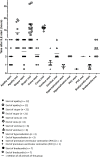Clinical effects and adverse effects of intravenous lipid emulsion treatment in dogs and cats with suspected poisoning
- PMID: 38809887
- PMCID: PMC11135785
- DOI: 10.1371/journal.pone.0298828
Clinical effects and adverse effects of intravenous lipid emulsion treatment in dogs and cats with suspected poisoning
Abstract
This retrospective study aimed to evaluate the effects on the clinical signs of poisoning and adverse effects of intravenous lipid emulsion treatment in 82 animals (dogs and cats) with suspected poisonings over 18 months. Physical examination parameters and state of consciousness were documented every hour after the intravenous administration of a bolus of 2 ml/kg and 0.25 ml/kg/min over 60 minutes of a 20% intravenous lipid emulsion. The modified Glasgow coma scale and laboratory findings (blood gas analysis, triglyceride, lactate) were evaluated initially and three hours after discontinuing intravenous lipid emulsion administration. A statistical evaluation of the occurrence of adverse effects and the development of laboratory values was performed. A decrease in respiratory rate in the second control (8-12 hours) after ILE was observed. Three hours after completing of the intravenous lipid emulsion, triglyceride concentration increased about 10 times (p <0.001). Venous carbon dioxide partial pressure, bicarbonate, base excess, as well as the electrolytes sodium, potassium and ionized calcium decreased significantly (p <0.001). Patients who experienced a worsening of the modified Glasgow coma scale had a higher increase in triglyceride concentrations (p = 0.041) and plasma lactate (p = 0.034) and a larger decrease in bicarbonate concentrations (p = 0.053) compared to others. About 54% (n = 44) of the patients showed adverse effects which could be attributed to the administration of intravenous lipid emulsion and may be associated with a higher triglyceride increase. All of them were completely reversible within 33 hours. Adverse effects associated with intravenous lipid emulsion therapy were observed in half of the patients and were associated with a higher increase in triglycerides.
Copyright: © 2024 Kiwitz et al. This is an open access article distributed under the terms of the Creative Commons Attribution License, which permits unrestricted use, distribution, and reproduction in any medium, provided the original author and source are credited.
Conflict of interest statement
The authors have declared that no competing interests exist.
Figures


Similar articles
-
Alpha-chloralose poisoning in 25 cats: clinical picture and evaluation of treatment with intravenous lipid emulsion.J Feline Med Surg. 2024 Apr;26(4):1098612X241235776. doi: 10.1177/1098612X241235776. J Feline Med Surg. 2024. PMID: 38687210 Free PMC article.
-
Lipid emulsion improves Glasgow coma scale and decreases blood glucose level in the setting of acute non-local anesthetic drug poisoning--a randomized controlled trial.Eur Rev Med Pharmacol Sci. 2012 Mar;16 Suppl 1:38-42. Eur Rev Med Pharmacol Sci. 2012. PMID: 22582483 Clinical Trial.
-
Intravenous lipid emulsion for the treatment of poisonings in 313 dogs and 100 cats (2016-2020).Front Vet Sci. 2023 Sep 28;10:1272705. doi: 10.3389/fvets.2023.1272705. eCollection 2023. Front Vet Sci. 2023. PMID: 37841477 Free PMC article.
-
Lipid Therapy for Intoxications.Vet Clin North Am Small Anim Pract. 2017 Mar;47(2):435-450. doi: 10.1016/j.cvsm.2016.10.018. Epub 2016 Dec 21. Vet Clin North Am Small Anim Pract. 2017. PMID: 28012788 Review.
-
What are the adverse effects associated with the combined use of intravenous lipid emulsion and extracorporeal membrane oxygenation in the poisoned patient?Clin Toxicol (Phila). 2015 Mar;53(3):145-50. doi: 10.3109/15563650.2015.1004582. Epub 2015 Jan 29. Clin Toxicol (Phila). 2015. PMID: 25634667 Review.
References
MeSH terms
Substances
LinkOut - more resources
Full Text Sources
Medical
Miscellaneous

